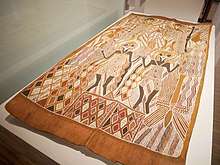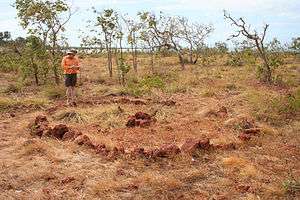Yirrkala
Yirrkala is a small community in East Arnhem Shire, Northern Territory of Australia,[1][2] comprising predominantly Aboriginal Australians[1] of the Yolngu people. It is 18 kilometres (11 mi) south-east from the large mining town of Nhulunbuy in Arnhem Land. In the 2016 census, Yirrkala had a population of 809 people.[1]

Yirrkala is also home to a number of Mission Aviation Fellowship pilots and engineers based in Arnhem Land providing air transport services.
History
At the 2006 census, Yirrkala had a population of 687.[3]
There has been an Aboriginal community at Yirrkala throughout recorded history, but the community increased enormously in size when Yirrkala mission was founded in 1935. Local governance and planning are now the responsibility of the Yolngu-led Dhanbul,[4] which is roughly equivalent to a shire council in non-Indigenous communities.
Culture


Yirrkala is home to a number of leading Indigenous artists, whose traditional Aboriginal art, particularly bark painting, can be found in art galleries around the world, and whose work frequently wins awards such as the Telstra National Aboriginal and Torres Strait Islander Art Awards.[5] Their work is available to the public from the Buku-Larrnggay Mulka Art Centre and Museum[6] and also from the YBE art centre. Pioneer Bark Painters from this region the National Museum of Australia consider old masters include Mithinarri Gurruwiwi, Birrikitji Gumana and Mawalan Marika.[7][8]
It is also a traditional home of the Yidaki (didgeridoo), and some of the world's finest didgeridoos are still made at Yirrkala.
Buku-Larrnggay Mulka Centre
The Buku-Larrnggay Mulka Centre, formerly Buku-Larrŋgay Arts and also known as the Buku-Larrnggay Mulka Art Centre and Museum, is a world-renowned centre, with well-known artists such as Nyapanyapa Yunupingu based there.[9]
The inspiration for the gallery arose in the 1960s, when Narritjin Maymuru set up his own gallery on the beachfront.[10]
In 1976 Buku-Larrŋgay Arts was established by local artists in the old Mission health centre, after missionaries had left and as the Aboriginal land rights and Homeland movements gathered pace. A new museum was built in 1988 using a Bicentenary grant, and this now contains a collection created in the 1970s which illustrates clan law. It also houses the message sticks[10] which, after delivery by the anthropologist Donald Thomson were instrumental in establishing peaceful talks during the Caledon Bay crisis in 1935.[11]
In 1996, extra gallery spaces and a screen print studio were built, and in 2007, The Mulka Project was added. This project comprises a collection of many thousands of historical images and films, and continues to create new digital art and images.[10]
The current centre, greatly expanded, comprises two divisions: the Yirrkala Art Centre, which represents the artists exhibiting and selling contemporary art, and The Mulka Project, which incorporates the museum.[10]
Land rights
Yirrkala played a pivotal role in the development of the relationship between Indigenous and non-Indigenous Australians when the document Bark Petition was created at Yirrkala in 1963 and sent to the Federal Government to protest at the Prime Minister's announcement that a parcel of their land was to be sold to a bauxite mining company. Although the petition itself was unsuccessful in the sense that the bauxite mining at Nhulunbuy went ahead as planned, it alerted non-Indigenous Australians to the need for Indigenous representation in such decisions, and prompted a government report recommending payment of compensation, protection of sacred sites, creation of a permanent parliamentary standing committee to scrutinise developments at Yirrkala, and also acknowledged the Indigenous people's moral right to their lands. The Bark Petition is on display in the Parliament House in Canberra.[12]
Heritage listings

Yirrkala has a number of heritage-listed sites, including:
Notable people
- Roy Marika (1925–93), councilor and artist
- Nonggirrnga Marawili (c.1938), painter
- Nyapanyapa Yunupingu (c.1945), painter
- Galarrwuy Yunupingu (1948–), land rights activist and Chair, Northern Land Council
- Gatjil Djerrkura (1949–2004), ceremonial leader
- Mandawuy Yunupingu (1956–2013), musician and educator
- Raymattja Marika (c.1959–2008), scholar, educator, linguist and cultural advocate
- Yothu Yindi (1986–2000), rock band
- Nathan Djerrkura (1988–), Australian rules footballer
- Maminydjama Maymuru (1997–), model
- Timmy Burarrwanga, businessman and cultural leader
References
- Australian Bureau of Statistics (27 June 2017). "Yirrkala (SSC)". 2016 Census QuickStats. Retrieved 13 October 2018.

- "Yirrkala". NT Place Names Register. Northern Territory Government. Retrieved 14 October 2018.
- Australian Bureau of Statistics (25 October 2007). "Yirrkala (L) (Urban Centre/Locality)". 2006 Census QuickStats. Retrieved 11 February 2012.
- Dhanbul
- "Art Right Now2 - IndgRes". gallery.discoverymedia.com.au. Retrieved 16 November 2018.
- "Buku Art Centre". Retrieved 16 November 2018.
- Old masters : Australia's great bark artists. National Museum of Australia. (1st ed.). Canberra, ACT, Australia. 2013. ISBN 9781921953163. OCLC 857187130.CS1 maint: others (link)
- "Mawalan Marika | Yirrkala bark Painting | painting | sell Mawalan Marika painting". Aboriginal Bark Paintings. 18 October 2017. Retrieved 22 August 2019.
- "Coronavirus restrictions are easing, and now this NT gallery is marking two milestones - ABC News". ABC (Australian Broadcasting Corporation). 29 May 2020. Retrieved 30 May 2020.
- "Buku-Larrŋgay Mulka". Buku-Larrŋgay Mulka Centre. Retrieved 30 May 2020.
- Kelly, Piers (4 July 2019). "Australian message sticks: Old questions, new directions". Journal of Material Culture. SAGE Publications. 25 (2): 133–152. doi:10.1177/1359183519858375. ISSN 1359-1835.
- "Yirrkala - East Arnhem Government" "http://www.eastarnhem.nt.gov.au/index.php?option=com_content&view=article&id=71&Itemid=150"
- "Wurrwurrwuy (Place ID 106088)". Australian Heritage Database. Department of the Environment. Retrieved 13 October 2018.